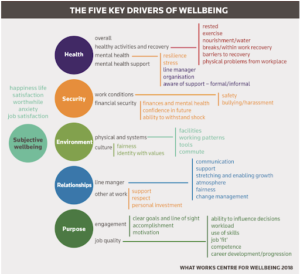Creating an environment that sustains wellbeing
There is a tendency in workplaces to focus on what is ‘acute’ in terms of helping employee wellbeing rather than what might be chronic. Organisations often still operate within silos, fixing each problem in isolation as it arises.
To create an environment that sustains wellbeing, employers should instead be looking at longer term preventative measures. Research from Deloitte in 2019 found that the return on investment for preventative mental health interventions was higher than for those that were reactive.
Employers are not mental health professionals, and for acute issues they can point their employees to places they can go to for help. But nurturing the workforce to be the best they can be creates an environment that sustains wellbeing in the long term. This involves focussing on:
- Workplace culture
- Employee voice
- Inclusion
- Job quality
- Good management
Experience over expectations
It is also important for employers to accept that they’re not always going to get everything right, particularly post-pandemic, as we’re all on a journey of change. Organisations should look at what employee experience looks and feels like when you get it right, and how this can be measured, rather than set expectations and have the experience fall short.
This involves training managers in how to embed a positive culture, coach people, respond to employee’s’ experience and needs – and be held to account.
Growing the evidence base
The What Works Centre for Wellbeing is driving the gathering of the evidence base that underpins wellbeing interventions at work. This is vital so that different organisations can invest in the right interventions that will work for them, and for their workforce.
While research continues into the many factors that influence wellbeing in the workplace, we do know enough to have developed a simple model that several organisations have adopted. This evidence-based model identifies five main drivers of wellbeing in the workplace, in order of importance:
- Health, Relationships
- Security, Environment
- Purpose

The Workplace Wellbeing Question Bank also includes a list of questions that can be used by employers to measure and monitor the wellbeing of employees. By asking people directly about how they feel about various aspects of the job, employers can target wellbeing activities and programmes to improve wellbeing.
Further discussion
Watch the full webinar to see further discussion around questions from the audience including:
- Can wellbeing be integrated into ESG?
- What is your top preventative idea for creating a culture of wellbeing?
- What are the good tools and resources to open up the conversation on wellbeing in the workplace?
- What are your ideas for zero budget wellbeing interventions?
- How do interventions like this work when you run a production line or have strict targets?
